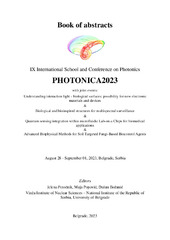Приказ основних података о документу
All-dielectric optical metasurfaces for sensing of substances with identical real parts of refractive index
| dc.creator | Obradov, Marko | |
| dc.creator | Jakšić, Zoran | |
| dc.creator | Mladenović, Ivana | |
| dc.creator | Rašljić-Rafajilović, Milena | |
| dc.creator | Vasiljević-Radović, Dana | |
| dc.date.accessioned | 2023-10-16T15:50:11Z | |
| dc.date.available | 2023-10-16T15:50:11Z | |
| dc.date.issued | 2023 | |
| dc.identifier.isbn | 978-86-7306-165-8 | |
| dc.identifier.uri | https://cer.ihtm.bg.ac.rs/handle/123456789/6759 | |
| dc.description.abstract | Metasurfaces are one of the most attractive research fields in recent years, in no small measure due to their use as refractometric sensors with unparalleled sensitivity, enabling sensing of even single atoms or molecules. This sensitivity is rooted in their ability to localize electromagnetic fields in volumes orders of magnitude below the diffraction limit. This is achieved by special geometry and refractive index contrast of metasurface nanocomposites. A plethora of both conductive (metals, TCO, graphene, MXenes...) and dielectric (oxides, semiconductors) materials can be used, all of them bringing different functionalities which further enhance the freedom of design when tailoring metasurfaces. However, the fundamental sensing mechanism is practically identical across all platforms and is based on the spectral shift of transmission or reflection due to a difference in the values of the real parts of refractive index between analyte and the environment. Here we propose an alternative approach, the use of exceptional capabilities of optical metasurfaces in transforming optical space to sense analytes with identical real parts of refractive index but different imaginary parts (losses). This is becoming increasingly important with the need to detect airborne viruses. We propose a metasurface formed by cruciform openings in a thin silicon layer on a SiO2 substrate, as shown in Fig. 1a. The structure is suspended in the air. For our FEM simulation we used measured values for Si and SiO2 refractive index taken from literature. The electric field distribution and its circular power flow, both at a wavelength of 630 nm, are shown in Fig. 1b. We gradually increase the imaginary part of the refractive index in the cruciform openings, starting with the lossless case, while maintaining the real part of refractive index equal to unity (air). The dispersive properties that depend on the value of the imaginary part are shown in Fig. 1c. The circular power flow that increases the optical path, the field localization and intrinsically low losses of the structure in the visible range all cause that adding even the smallest volumes of analyte with slightly increased optical absorption in comparison to the metasurface significantly reduces transmission through the structure, despite the exceptionally low structure thickness. | sr |
| dc.language.iso | en | sr |
| dc.publisher | Belgrade : Vinča Institute of Nuclear Sciences – National Institute of the Republic of Serbia, University of Belgrade | sr |
| dc.relation | info:eu-repo/grantAgreement/MESTD/inst-2020/200026/RS// | sr |
| dc.rights | openAccess | sr |
| dc.rights.uri | https://creativecommons.org/licenses/by-nc-nd/4.0/ | |
| dc.source | Book of abstracts - IX International School and Conference on Photonics PHOTONICA2023, August 28 - September 01, 2023, Belgrade, Serbia | sr |
| dc.subject | Metasurfaces | sr |
| dc.subject | refractometric sensors | sr |
| dc.title | All-dielectric optical metasurfaces for sensing of substances with identical real parts of refractive index | sr |
| dc.type | conferenceObject | sr |
| dc.rights.license | BY-NC-ND | sr |
| dc.citation.spage | 127 | |
| dc.citation.epage | 127 | |
| dc.citation.rank | M34 | |
| dc.identifier.rcub | https://hdl.handle.net/21.15107/rcub_cer_6759 | |
| dc.identifier.fulltext | http://cer.ihtm.bg.ac.rs/bitstream/id/27290/bitstream_27290.pdf | |
| dc.type.version | publishedVersion | sr |


